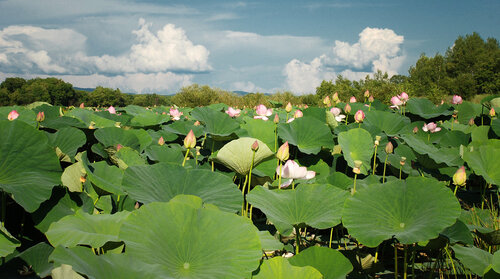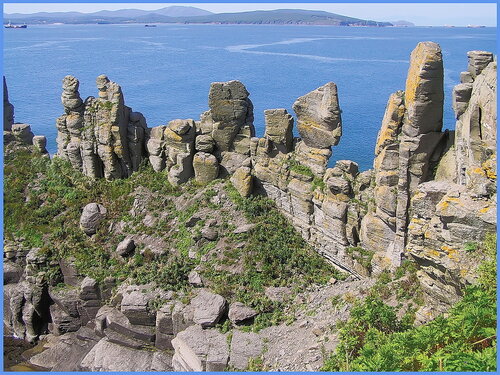
«"перед мощной властью красоты"» на Яндекс.Фотках
This remarkable region spreads across the very southernmost part of the Far East. In the north and the west it is encircled by the river Amur, with its tributary the Ussuri, while in the south and east – it borders on the warm Sea of Japan.

«побережье 20х15» на Яндекс.Фотках

«Осень у моря» на Яндекс.Фотках
The major part of the territory is taken up by the mountains of Sikhjote-Alinj.

«Башня в тайге» на Яндекс.Фотках
The location of Ussuriysk region, its rare combination of winds, currents, terrain and water basins created a climatic anomaly that enables both northern and southern plant and animal life to populate the region side by side. This resulted in a remarkable world all its own, without analogues anywhere else.
Just imagine taiga firs embraced by graceful vines, such as wild grapes and the medicinal magnolia vine. Moreover, one of the species of vines – actinidia – grows to a diameter of 20 centimeters! The Siberian larch grows alongside the powerful Korean cedar, oaks and maples neighbor on Manchurian hazel and corkwood.
On Lake Hanka the lotus grows alongside the familiar to us sedge and reed. And certainly an unusual sight are tropical bushes of the spiky sarsaparilla.

«Лотосы озера Ханка» на Яндекс.Фотках
No less unusual is the animal life of the region: living here in comfortable co-habitat are residents of the Siberian Taiga – the brown bear, wolverine, wolf, elk, boar, squirrel, sable and such residents of the south as: leopard, raccoon dog, dappled deer and the famous Ussuriysk tiger. It is notorious not only for its size, but wondrously beautiful fur. This is a fast and deft beast. In order to preserve its population, the Ussuriysk tiger has been entered into the Red Book of endangered species.

«Амурский тигр» на Яндекс.Фотках
The central Russian adder and lizard share territory with the huge as a python Manchurian black water snake and sleep turtle. Koreans living along the Ussury have long been keeping house snakes instead of cats to keep down the rodent population.
Besides living wonders, the region is famous for the richness of its mineral wealth. It’s considered to be the third in Russia (after the Urals and Transbaikal) treasure store of semi-precious stones. In the mountains of Sikhote-Alinj they find crystal, amethysts, garnets and tourmaline.
No less remarkable is the underwater world of the Sea of Japan. Here, in Peter the Great Bay, the first Russian marine nature preserve was established. Among its inhabitants both tiny, millimeter-long, barnacles, and almost half a meter in diameter jelly fish; huge shafts of seaweed- kasteria – with a length of 1,5 meter and a width of up to half a meter. Alongside them swaying gently are long scrolls of laminaria seaweed. But the greatest numbers are represented by mollusks. These are oysters, mussels, scallops, trepan, octopus, squid, and ink fish. The breeding power of the mollusks is amazing. Thus, one female mussel is capable of producing 50-70 million spawn annually. If we take into account that mussels live for 100 years and more, you can imagine what a mind-boggling number of offspring they produce in their lifetime!

«Кеккуры, бастион» на Яндекс.Фотках

«Звёздный натюрморт» на Яндекс.Фотках
On the bed of Peter the Great Bay we can find numerous starfish of diverse shapes and colors, sea acorns, sea urchins, and soldier-crabs. In the tangle of eel grass the there graze the wondrous creatures — the grass shrimp — throughout their life persistently changing sex.
The remarkable world of inhabitants of Peter the Great Bay is represented in an exposition of the Museum of Marine life, situated on the nearest to Vladivostok, Isle of Popov.
For those wishing to visit the jungle, there is no need to go to Africa. One can find a veritable riot of nature, closely reminiscent of the jungle, on Russian soil, in the Ussuriysk region.
Source:The Voice of Russia


4 комментария:
another wonderful article. LOve all those photos. Is this the area that is the eastern end of the Trans Siberian Railway?
Thanks, Lastochka, your posts continue to fascinate me.
Is the town of Khabarovsk in this region? As far as I know, it's a magnificent town, with classic european flavour in the extreme east Siberia, rich in churches, parks, museums...
Mario
Heather, yes it is)Thank you))
Mario,you're right.
Отправить комментарий